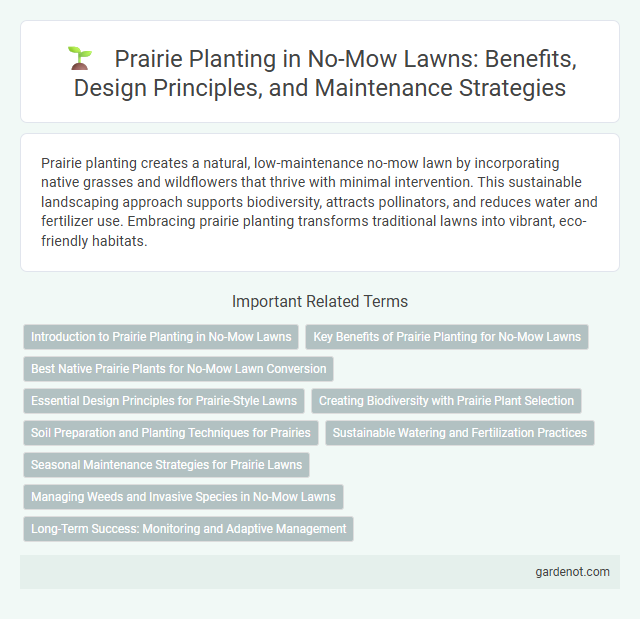Prairie planting creates a natural, low-maintenance no-mow lawn by incorporating native grasses and wildflowers that thrive with minimal intervention. This sustainable landscaping approach supports biodiversity, attracts pollinators, and reduces water and fertilizer use. Embracing prairie planting transforms traditional lawns into vibrant, eco-friendly habitats.
Introduction to Prairie Planting in No-Mow Lawns
Prairie planting in no-mow lawns involves establishing native grasses and wildflowers that require minimal maintenance and mimic natural ecosystems. Selecting drought-tolerant species like Little Bluestem, Indian Grass, and Purple Coneflower supports biodiversity and reduces water usage. This sustainable approach promotes soil health, attracts pollinators, and eliminates frequent mowing, making it ideal for eco-friendly landscaping.
Key Benefits of Prairie Planting for No-Mow Lawns
Prairie planting enhances no-mow lawns by promoting biodiversity and supporting pollinators such as bees and butterflies, creating a vibrant ecosystem. Native prairie grasses and wildflowers require minimal maintenance, reducing water usage and eliminating the need for chemical fertilizers and pesticides. This natural landscaping approach improves soil health through deep root systems while providing year-round visual interest with seasonal blooms.
Best Native Prairie Plants for No-Mow Lawn Conversion
Big bluestem (Andropogon gerardii), purple coneflower (Echinacea purpurea), and little bluestem (Schizachyrium scoparium) are among the best native prairie plants for no-mow lawn conversion, offering drought tolerance and low maintenance. These species provide deep root systems that improve soil health, enhance biodiversity, and support pollinators like bees and butterflies. Incorporating switchgrass (Panicum virgatum) into the mix increases erosion control, making it an ideal choice for sustainable landscape design.
Essential Design Principles for Prairie-Style Lawns
Prairie-style lawns thrive by incorporating biodiversity, selecting native grasses and wildflowers suited to local climate zones, and arranging plants in clusters to mimic natural prairie patterns. Emphasizing deep-rooted species enhances soil health and drought resistance, promoting sustainability and reducing maintenance needs. Layering plant heights creates visual texture and supports local pollinators, ensuring ecological balance in the lawn ecosystem.
Creating Biodiversity with Prairie Plant Selection
Prairie planting with diverse native grasses and wildflowers enhances biodiversity by providing habitat for pollinators, birds, and beneficial insects. Selecting species such as big bluestem, purple coneflower, and black-eyed Susan fosters ecological balance and soil health in no-mow lawns. This approach supports sustainable landscapes by reducing maintenance needs and promoting resilient ecosystems.
Soil Preparation and Planting Techniques for Prairies
Effective prairie planting begins with thorough soil preparation, including deep tilling to reduce compaction and incorporate organic matter, which enhances soil fertility and drainage. Selecting native prairie species adapted to local conditions and employing seed drills or shallow broadcasting techniques ensures optimal seed-to-soil contact and germination rates. Proper spacing and planting depth are critical to establish resilient root systems that support long-term prairie ecosystem health.
Sustainable Watering and Fertilization Practices
Prairie planting in no-mow lawns significantly reduces water consumption by utilizing deep-rooted native grasses that efficiently access groundwater, minimizing the need for frequent irrigation. Sustainable fertilization relies on organic compost and natural soil amendments to enhance soil fertility without introducing harmful chemicals, supporting long-term ecosystem health. This approach promotes resilient plant growth while conserving water resources and reducing environmental impact.
Seasonal Maintenance Strategies for Prairie Lawns
Seasonal maintenance strategies for prairie lawns emphasize targeted mowing schedules that align with native grass growth patterns to promote biodiversity and soil health. Early spring mowing at a height of 4-6 inches removes dead material, stimulating new shoots and controlling invasive species, while late fall mowing prevents seed dispersal of unwanted plants. Implementing periodic burning or controlled grazing can further enhance prairie lawn vigor by recycling nutrients and maintaining habitat structure.
Managing Weeds and Invasive Species in No-Mow Lawns
Prairie planting in no-mow lawns creates dense native vegetation that suppresses weeds by outcompeting them for resources. Regular monitoring and targeted removal of invasive species such as Canada thistle and garlic mustard prevent their establishment and preserve biodiversity. Strategic use of native prairie grasses and wildflowers enhances soil health and promotes a resilient, low-maintenance landscape.
Long-Term Success: Monitoring and Adaptive Management
Prairie planting for no-mow lawns requires ongoing monitoring to assess plant health, species diversity, and weed control. Adaptive management strategies involve adjusting mowing frequency, soil amendments, or supplemental seeding to respond to ecological changes over time. Long-term success depends on consistent evaluation and timely interventions to maintain a resilient, sustainable prairie ecosystem.
Prairie planting Infographic

 gardenot.com
gardenot.com